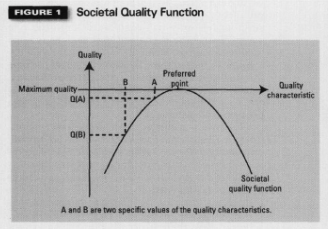What is quality?
There are a variety of definitions offered in literature used in different contexts by researchers. To better understand what is meant by quality in manufacturing, we look at some different definitions that have been used during the development of manufacturing practices.
Throughout these articles, we'll refer also to Recommended literature, which you are welcome to look up. We update our sources on an ongoing basis.
Defining quality
Differentiating between definitions
The different definitions of quality can be categorised into groups. There are five approaches that can be used to differentiate between the definitions of quality:
Transcendent approach – quality is unanalyzable property;
Product based approach – quality is the difference in the quantity of ingredients or properties;
User based approach – quality is different through the eyes of each individual;
Manufacturing based approach – quality is the conformance to requirements;
Value based approach – quality is defined in the terms of cost and price.
(Garvin 1984)
Definitions
Crosby
Crosby (1979), defines quality as “conformance to requirements”. This means that a set of requirements that characterise the product from the customers’ viewpoint can be created, if the set requirements are met, the product conforms to requirements. (Sparks & Legault, 1993)
Deming
Deming (1988), declares that the difficulty of defining quality is due to the ever-changing needs of the customer and that quality can be viewed differently depending on perspectives. For example Deming (1988) states that good quality to a production worker means pride, bad quality means loss of job. To a plant manager quality means meeting given specifications.
The main arguments that Deming makes are:
There are different degrees of quality;
Quality is multidimensional;
Quality must be defined on the basis of customer satisfaction. (Brooke et al. 2001)
Taguchi
Taguchi (1979), stated that “Quality is the loss a product causes to society after being shipped” The key element in that statement is that Quality is a loss, a concept hard to adopt. It can be much more easily illustrated though.
Characteristics of quality
Quality characteristics play an important role in Taguchi’s definition of quality, so it is important to define them. According to Garvin (1984) the many dimensions of quality are:
Performance – main characteristics of operation of a product;
Features – secondary characteristics of a product that supplement the basic functioning;
Reliability – the probability of failure in a given time period;
Durability – measure of product life;
Conformance – degree to which the product matches pre-established standards;
Serviceability – competence, speed and the courtesy of repair;
Aesthetics – the look, sound, taste, smell, etc. of the product;
Perceived Quality – image based product evaluation.
Figure 1 shows as a social quality function, where the horizontal axis represents the ‘Quality characteristics’ or the quality wanted and the vertical axis represents ‘Maximum quality’ or the quality experienced by the society. Preferred point is the point where maximum quality experience occurs. In this case we can clearly see that Q(A)>Q(B) meaning the quality experience from product A is greater than from product B. Though when we look at Taguchis’ statement then Figure 1 does not fully exploit it, as he describes quality as loss. To achieve this we simply need to flip the figure and characterize the axis. Horizontal axis still represents ‘Quality characteristics’ the vertical axis represents ‘Maximum loss’, as we can see on Figure 2. What Taguchi meant with his statement, was that we maximize quality by minimizing the loss to society. In Figure 2 point A is closer to the preferred point and thus offers greater quality experience to the society, meaning it minimizes the loss to the society. This is the objective that confronts the departments of every organization. (Brooke et al., 2001)


Conclusion
There are several different perspectives on how quality is perceived. To achieve the best solution you shouldn’t focus only one of them. If you want to read further how Lean and Six Sigma can help you increase your quality you should read our blog post about it!
Flowbase can help with several steps within implementing LSS in your organization. At Flowbase we have automated time and motion study (VSM) annotation, data collection and analysis. Flowbase uses computer vision and AI to automatically analyse any video footage that you upload, enabling you to easily analyse multiple material flows in parallel. All resulting data is gathered to a single dashboard and searchable indexed reports – and if you’re keen to see why the timeline looks the way it does in a particular place, then you can easily refer back to the original video footage. Now, if your production manager wants to compare benchmarks, then it’s a click away. All data is visualised automatically in an easily understandable manner, with historical data and improvements (or regressions) available for each process. If you need to drill down into more detail, then detailed by-the-second data is available in detailed process reports.